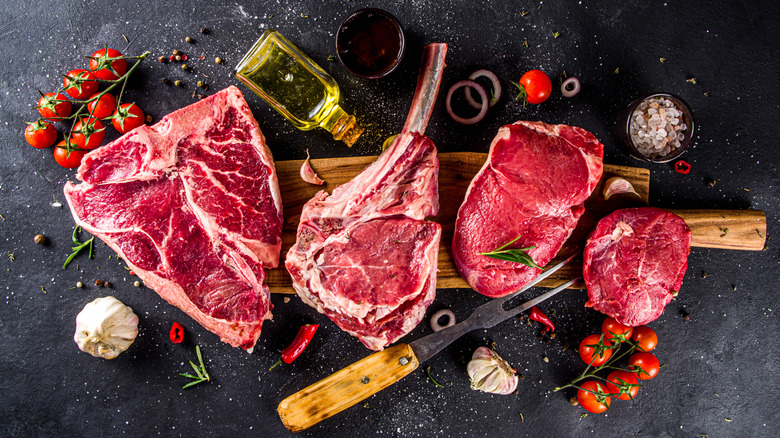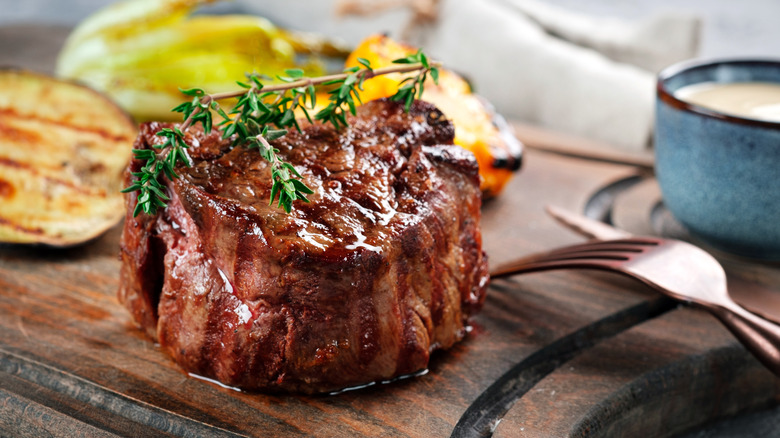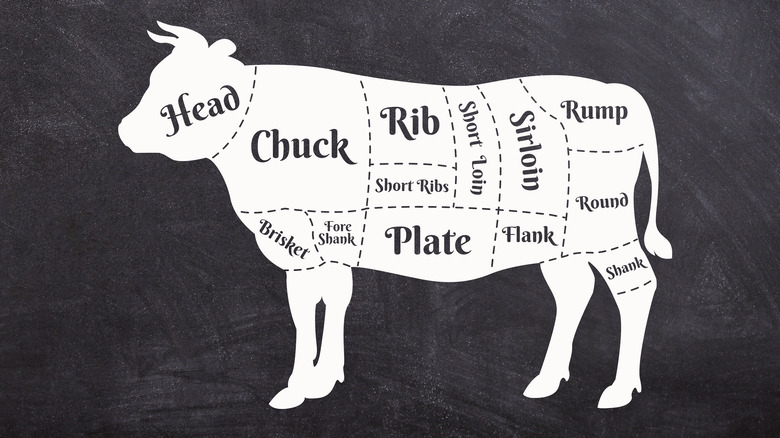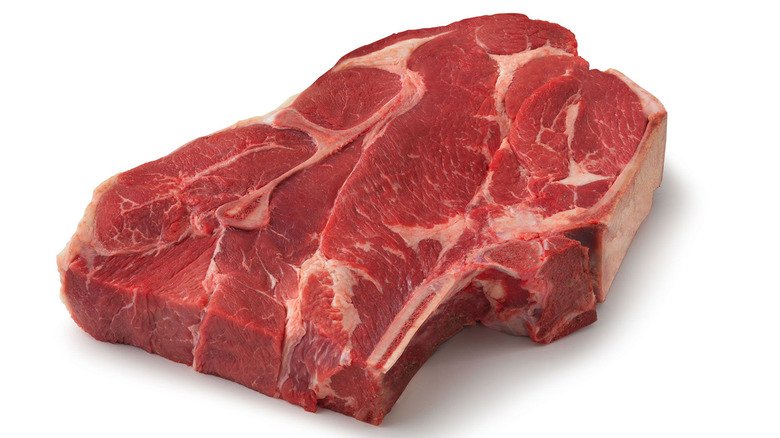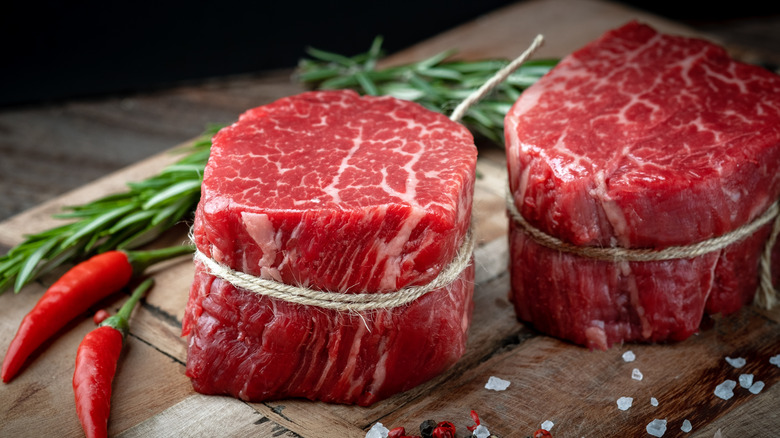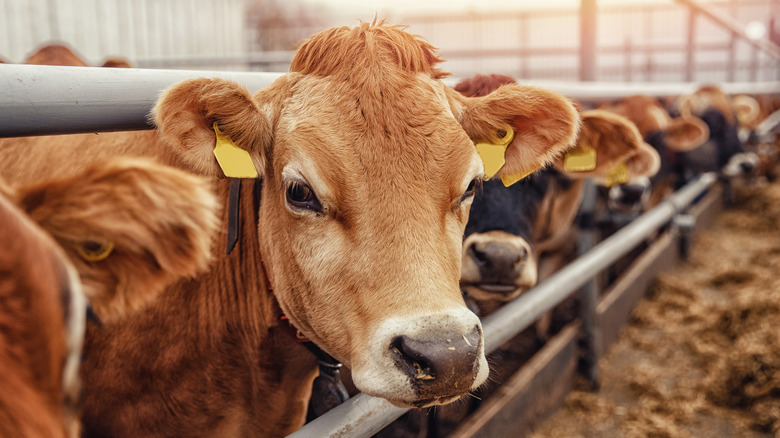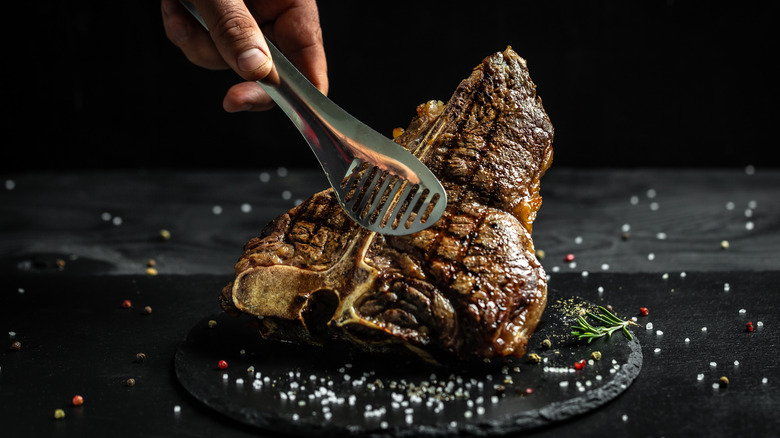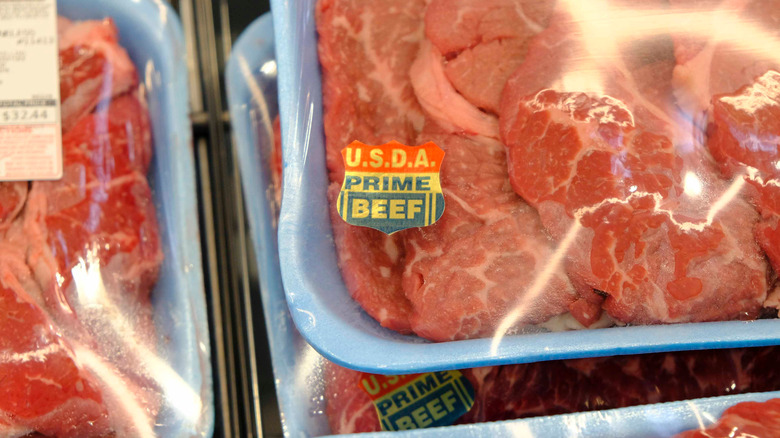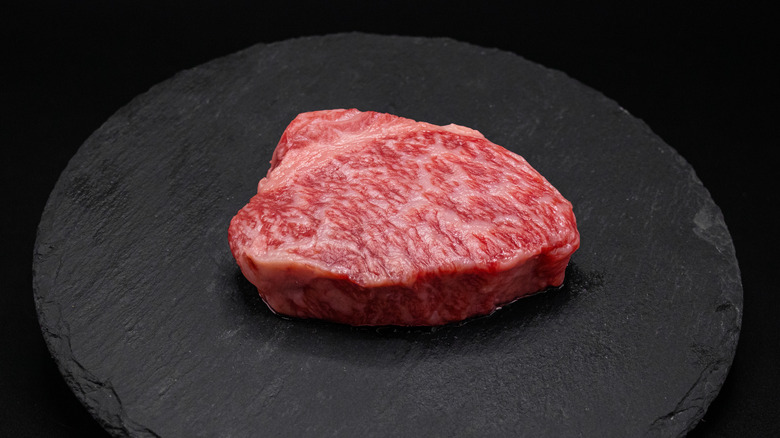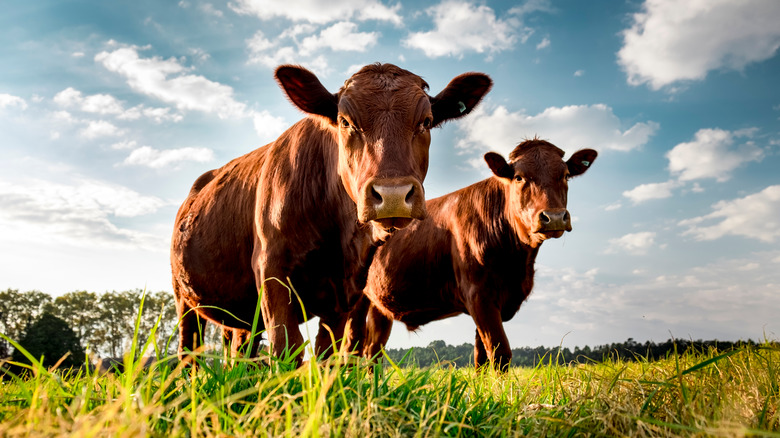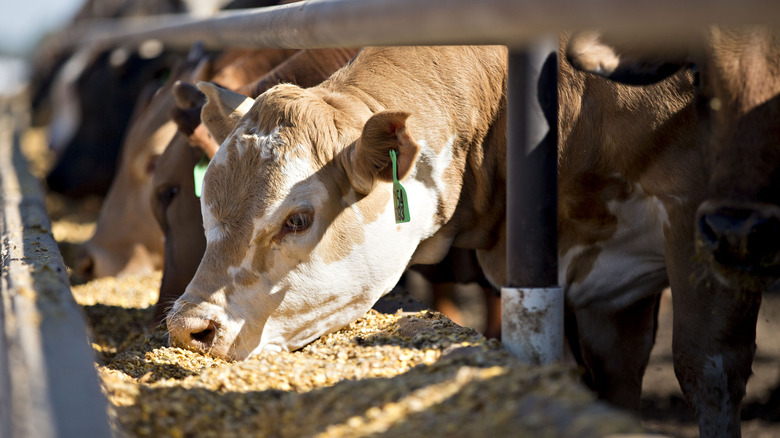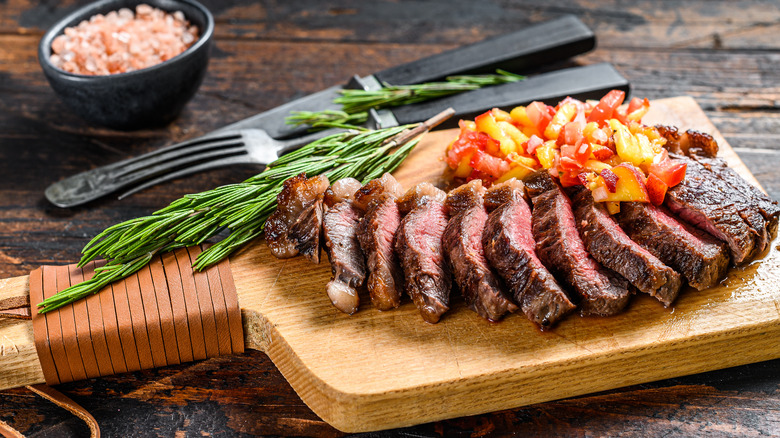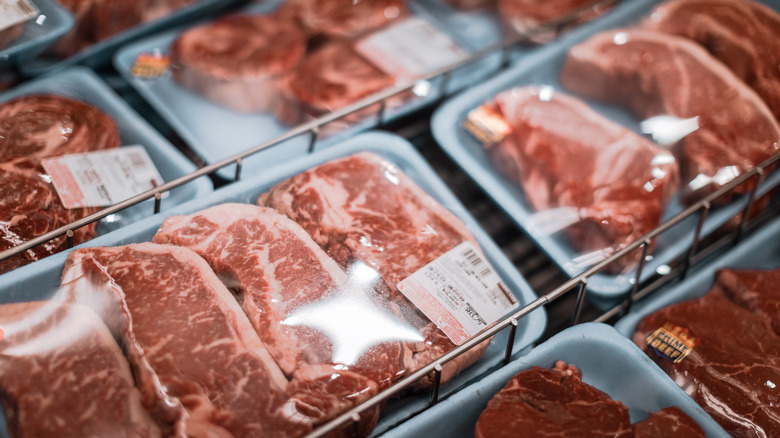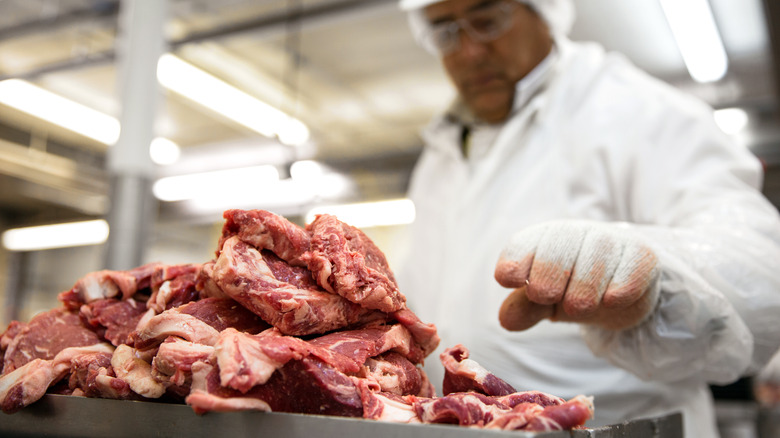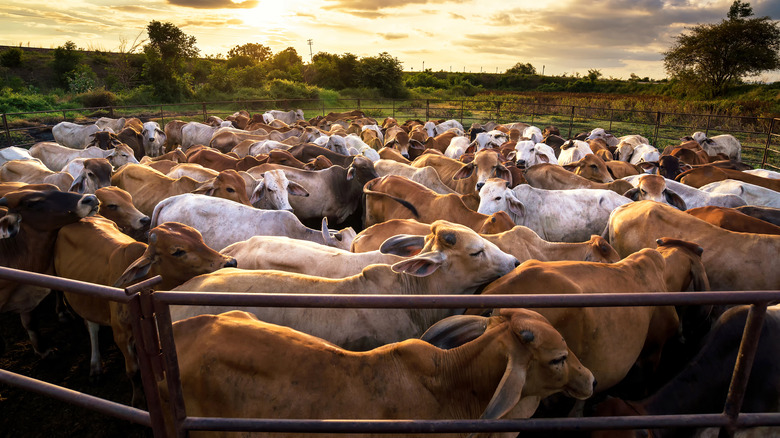The Real Difference Between Cheap Vs Expensive Steak
Steak has never been especially cheap, but prices are going up. Where you might have once said, "let's do a prime rib for Mother's Day," now it's more like, "let's do a London broil for Mother's Day," or even, "let's just roast a chicken." One thing's for sure: steak is definitely not a budget meal.
Even so, the difference between expensive and cheap steak is a bit of a moving target. Some steaks are costlier because they're tender, but that doesn't necessarily mean they're more flavorful. And cooking techniques can go a long way towards making a cheap, tough piece of meat into something delicious.
It's definitely worth knowing the differences between a cheap cut of beef and an expensive one. That way, you can plan your Mother's Day dinner, anniversary night out, or "just because" evening based on solid evidence rather than hearsay. Here are the real differences between cheap and expensive steak — you might be surprised to see what this means for your wallet.
Tender meat is expensive meat
The most expensive cuts of meat are expensive because the meat is tender. Consumers value tenderness and are willing to pay more for it. That's just a simple fact of beef buying. And there are only a few cuts of beef that are naturally tender right off the cow. Tenderloin, New York strip, T-bone (which essentially includes both the tenderloin and the New York strip), and rib-eye are the four most naturally tender cuts of beef. They're also the ones you'll pay more for at the supermarket.
Tenderness, though, doesn't just apply to beef the minute it comes off of the cow. You can also make meat that isn't naturally tender into something that comes pretty close to a tenderloin just by how you cook it. There are a number of smart pre-tenderizing strategies that work great on almost any cut of beef, even a chewy piece of chuck. Cook's Illustrated suggests soaking your beef for 15 minutes in a mixture of baking soda and water. Or, try a pineapple marinade. You can also tenderize your steak with a meat mallet, which helps break apart those connective tissues so the meat becomes less chewy and more falls-apart-in-your-mouth after cooking.
The expensive cuts are only part of the cow
Naturally tender cuts of beef are what everyone wants when they have too much money and someone they want to impress. But the tenderness of the beef isn't the only thing that makes these cuts so expensive. If the whole cow was tender, you wouldn't have to pay more for any particular cut of beef — it would all cost about the same.
But the reality is that tender cuts only make up about 8% of the cow. The rest of the meat is so inferior that the butcher has to raise the price of the tender cuts just to make up for what the store isn't making on the rest of the animal. So, buying a tenderloin is a little bit like paying more for a limited edition collectible. When you want something that a lot of other people want, but there's a limited supply, you can expect to pay a lot more for it. That's just economics.
You won't find gristle in expensive meat
Cheap steak contains a lot of connective tissue. Now, that tissue isn't always bad, and you'll actually find two different types in beef. According to the US Wellness Meats, collagen is present in cuts like brisket and top round, which are popular for braising or pot roasts. Collagen is actually good for these cuts because it breaks down with heat, per Kitchn. Slow cooking helps give these cuts an extra tender quality.
The other kind of connective tissue is elastin. You'll find elastin in the animal's ligaments, which means it shows up in the cuts of meat that come from the active parts of the animal such as the legs and haunches. Elastin is why you won't pay nearly as much for a chuck steak as you will for a tenderloin. Unlike collagen, elastin doesn't break down when you cook it. You have to cut it off if you want to rid your steak of those chewy, inedible bits popularly known as "gristle."
Why is tenderloin so tender?
There's a good reason why some cuts of meat are tender and some are not: the anatomy of the cow. Similarly, anatomy is also the reason why you get both white meat and dark meat on a chicken. The dark meat comes from parts of the chicken that get longer, more sustained workouts, like the legs and thigh. The white meat comes from parts of the chicken used for short bursts of activity, like the breast muscle. If you've ever wondered why the breast meat of a duck or goose is darker than the meat of a chicken or turkey, it's because ducks and geese have better flight capabilities.
In cows, the most expensive cuts of meat come from the loin. According to S. Clyde Weaver, the muscles in this part of the cow aren't weight-bearing and contain less connective tissue, which makes them more tender. On the flip side, the parts of the cow that get the most use (like its legs, shoulder, and haunches) have more of that aforementioned connective tissue. Those cuts are therefore much less tender than the cuts that come from the lesser-used parts of the animal.
Mass produced anything tends to be lesser quality
Back in the 1910s, Henry Ford realized you can make more money off your products if you have a lot of them to sell (via History). And so, the modern concept of mass production was born. Since then, the beef industry has taken this idea to heart. Big operations do everything they can to raise a lot of beef and get it to market quickly. To accomplish this, they employ strategies that some might find questionable, like giving their animals hormones so they will grow faster and be slaughtered more quickly.
Cattle raised on large, factory farms also typically live in crowded conditions, which makes them more likely to be contaminated with dangerous bacteria. To keep microbial disease down, ranchers sometimes give them preventative doses of antibiotics, which some argue makes the beef of lesser quality and perhaps even dangerous. With operations like this, you can get beef at cheaper prices, but you're getting a lesser quality piece of meat for your money and potentially dancing with the E. coli devil. According to Unique Flavors Catering, meat that's produced on factory farms tastes different, too, so if you have the extra money to spend you might decide it's worth it to look for beef that comes from small-batch producers.
Good steak really hinges on the skill of the chef
Beef is expensive in a grocery store, and even more so in a restaurant. You might pay $24 for a pound of tenderloin at Safeway, but if you order the same tenderloin at Outback Steakhouse you'll probably pay at least that much for only a six-ounce portion. And that's Outback Steakhouse — try ordering a tenderloin at a five-star restaurant and you might have to make payments on your dinner for a couple of months.
The good news is, you don't have to order tenderloin in order to have a delicious restaurant steak experience. That's because the flavor of the steak you get in a restaurant is more about the skill of the chef than it is the cut of beef.
A perfectly cooked steak is salted, brought to room temperature, lightly seasoned, and then cooked fast at a high temperature. And it's never served immediately after cooking. When you let the steak rest, that seals in the juices and helps ensure that you won't end up with a dry hunk of chewy unpleasantness next to your baked potato. Now, if the same talented chef is cooking the porterhouses and the sirloins, you still might prefer the porterhouse, but you're certainly not going to be disappointed by the sirloin. You just need to know where that talented chef works.
Not all tenderloins are created equal
In some stores, you may have the option of paying $24 for a pound of tenderloin and $37 for what appears to be the exact same thing — except for the grade. According to Clover Meadows Beef, the grade of a piece of meat is decided by a US Department of Agriculture inspector. To make this determination, the inspector looks at the marbling in one specific part of the cow: between the 12th and 13th rib. "Marbling" is the term used to describe those thin, streaky bits of fat that may or may not run through a piece of meat (via Meat Science). A prime cut of beef generally has more marbling.
USDA inspectors put the beef they inspect into one of three categories: A prime cut of beef is considered the highest quality, and therefore costs the most. Prime cuts represent only about 2% of what's on the market in America. The next category is "choice," which is not quite as good as prime but is better than the third category, "select."
Most of the beef available in the US is choice. As you may expect, you'll pay more for the prime cut, a little less for choice, and not as much as either for select.
The most expensive beef of all
If you really want to spend a lot of money on steak, look for wagyu beef. But you're probably not going to find it at your local Albertsons. According to Business Insider, this Japanese-bred beef is the most expensive in the world, costing you up to $200 a pound. So, if you plan to enjoy a small wagyu steak with all four members of your clan, you can expect to spend about one monthly payment for a new, moderately priced car. If you'd like to invest in an entire wagyu cow, plan to drop about $30,000.
Why is this particular beef so expensive? Wagyu cattle are a high-endurance breed, meaning they have more fat in their muscles. But that's not all — when wagyu calves are about 10 months old, they go to a "fattening farm" where they stand around in confined spaces for the next couple of years, eating nothing but carbs and fiber. By the time they're ready to go to slaughter, their bodies are about 50% fat. This is why wagyu beef has that prized flavor and texture. So if it's important to you to know that your beef has been humanely raised, you'll be pleased to hear that you can safely exclude one of these very expensive steaks from your list of acceptable foods.
Grass fed beef is more humanely raised and costly
Grass-fed beef is an alternative to the corn-fed beef you'll find in most of those Styrofoam packages in the meat department. The difference between the two is that one had a marginally better life than the other.
Grass-fed animals spend more time in the pasture, and they don't spend the last few months of their life in a feedlot getting fattened up. This means that they don't make it to market as quickly as a corn-fed cow. In fact, it can take up to an extra year to fatten them up, says Consumer Reports, bringing up the price. Pasture land is also harder to come by than feedlots, contributing to the higher price of grass-fed beef.
Effectively, you're paying more for slightly less guilt because. You can be pretty sure that your grass-fed cow lived a reasonably pleasant life before heading to a slaughterhouse. But what else are you getting for the extra money? The North American Meat Institute says grass-fed beef may be slightly more nutritious than corn-fed beef. It's also healthier in the sense that pasture-raised animals aren't living shoulder to shoulder with other animals during the last months of their life and are therefore less likely to carry unpleasant bacterial diseases.
Fat cows cost more
Marbling is generally what determines whether a cut gets the coveted prime label or is relegated to the lowly "select" category. Those categories exist because of presumed meat quality, but they still don't explain why you have to pay so much more for prime beef than for select.
It's also based on demand. Consumers prefer well-marbled pieces of meat, especially when they have that desirable "prime" label. Simple economics determines that things that are more desirable have higher price tags. After all, if everyone thought Gucci made a terrible handbag, you could probably find Gucci bags at your local Target.
According to Chef Steps, the other, much more practical reason why you spend more money on a marbled piece of beef is that it costs more money to fatten up a cow. Fat cows need more food, and they also need to eat that food for longer periods of time. More food costs more money, and so ranchers have to charge more for the beef in order to recoup those expenses.
Some cheap cuts taste better than expensive ones
Everyone says they would rather eat a piece of tenderloin than a sirloin, but is it really because they know the difference? Perhaps that has more to do with the fact that consumers automatically think products with higher price tags must be superior.
The truth is that in a flavor taste test, a sirloin would probably win. Tenderloin may have a leg up on tenderness, but it is also often milder in flavor than that modest restaurant standby, the sirloin. A sirloin has more connective tissue, which makes it a tougher piece of meat. The trade-off is that it has a stronger flavor which some people prefer over tenderloin.
According to Cattlemen's Restaurant, the sirloin comes from just in front of the rear leg of the cow, meaning it's in between a rump and a porterhouse in terms of how much action the muscle sees in a living cow. It's not as tender as a tenderloin, but it's also not as tough as a chuck steak. If you value flavor over tenderness, then this cut is arguably superior.
It depends on where you buy it
In America, one of the secrets to getting a better price on beef is shopping at a bulk discount store like Costco or Sam's Club. Still, you may wonder if the top sirloin you bought at Costco is somehow inferior. Happily, the answer is no. Probably. According to CNet, most of the beef at Costco is the same grade and quality as the beef at Safeway, just less expensive. Like everything else at Costco, though, you have to buy more of it in order to get those discount prices.
One of the drawbacks to buying your beef at Costco is that you may not be able to eat all of it before it goes bad. Unless you're planning to freeze the leftovers or host a giant dinner party, it may not be worth it. Costco ultimately works only if you're good at planning and are able to make the best use of what you buy.
It's also worth remembering that beef that comes from Costco is kind of, well, mysterious. That's because Costco isn't exactly transparent about where it sources that meat. So if humanely-raised beef is one of your priorities, you can't be sure that your Costco purchase checks that box.
Cheaper beef might be more dangerous
According to the CDC, mass-produced meat is more likely to contain contaminants like Salmonella and E. coli. That's not just because cattle that live in close conditions are more likely to spread these organisms. It's also because the plants that process and package lots of meat are at risk of introducing pathogens into the meat during handling. Even in the store, there are variables that can bring bacteria to meat.
For instance, you're getting a deal on the beef you buy at Costco, but CNet says that the way Costco handles their beef can create potential health hazards. Costco beef has been blade-tenderized, a process that can introduce bacteria into the center of a piece of meat. So if you're a fan of rare steak, in theory, that means you might get sick using blade-tenderized stuff.
Blade tenderizing does accomplish what it's meant to — it takes a naturally tough piece of beef and makes it more tender. Buying a Costco steak, therefore, means less effort in the kitchen, but it's not really that hard to hit a piece of steak a few times with a meat mallet. If that's what protects you from a foodborne illness, it kind of seems worth it.
Organic beef may not be what you think it is
There is one last category of expensive beef we should talk about: organic beef. If you're concerned about things like hormones, antibiotics, and pesticides in your food, you may want to buy only the organic stuff. Some people get organic confused with pasture-raised or humanely raised beef. Yet, just because it's organic doesn't mean it also falls into either one of those other categories.
In order to earn the "organic" label, beef cattle do have to have some room to roam, but that doesn't necessarily mean they lead better lives. According to Mic, organic farmers can't give their cattle hormones even when they're sick, so sick cows may end up dying for lack of medical treatment. And that "room to roam" rule only applies for around four months out of the year, so it's not like organic cattle get to spend a whole lot of time frolicking in pastures.
All of this means that organic beef may be healthier, but it's not necessarily better tasting and you don't get to have any of the feel-good effects of other beef. And you'll still pay more, simply because when farmers raise anything organically they tend to have more losses and have to charge more to make money.
